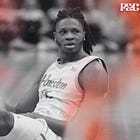Caleb Wilson's path to maximization through minimization
North Carolina's 6-foot-10 five-star recruit spent most of his high school career with the ball in his hands. When he took on a lesser role as a senior in the EYBL, his strengths began to shine.
For the longest time, Caleb Wilson was a wing. At Holy Innocents Episcopal School in Sandy Springs, Georgia, it was the correct path. He was the guy, head and shoulders and chest and knees over the rest of his team’s options. The ball was best in his hands, even if Wilson himself wasn’t at his best with it there.
Like many long, lanky teenagers thrust into high usage roles, Wilson did his best to impersonate the Kevin Durants, the Tracy McGradys, and other flashy hoopers who thrived on poster dunks and pull-up middies. It wasn’t always pretty, it was rarely efficient, but at 6 feet, 8 inches—soon to be 6 feet, 10 inches—it played its part in the top-10 ranking Wilson has held since he debuted in the class of 2025 rankings over three years ago.
Between the margins, however, there was something more. Something that hadn’t been able to show itself because of Wilson’s burden to handle, to rise and fire, to orchestrate.
In terms of pure tools, Wilson was the ideal small-ball five. A “tweener” big with the athleticism and length to dominate by finishing plays, extending possessions, leaking out on transition, and ultimately creating those opportunities on defense. It was a vision of something greater beyond the surface that had merely shown itself in flashes to that point.
As a rising senior, midway through the Nike EYBL season, Wilson made a move not many would struggle to even consider. He switched teams. Wilson, who had spent the years prior with his local Georgia Stars, flipped to Nightrydas Elite, the reigning two-time Peach Jam State Champions, with a core of high-major talent, including potential first pick in the 2026 NBA Draft, Cameron Boozer, his twin brother, Cayden Boozer, and four-star Miami commit Dante Allen.
In joining a team that had done so much winning, featuring a core that had done so together for their formative years, Wilson was destined to step into a lesser role, something he embraced. He’d never played with such talent, much less talent that had as much established chemistry. He wasn’t there to feature; he was there to win.
Wilson did both. He led the EYBL in combined steals and blocks by almost one a game, and dominated, leaking out in transition, cleaning up on the offensive glass, and as a constant threat rolling and cutting to the rim. He took fewer 3’s, barely operated in isolation and in the pick-and-roll, and was the better for it.
Where Wilson made his name, next to all of Nightrydas talent was on the defensive end. Six feet, 10 inches with whirling arms and springs in his legs, Wilson is tailor-made to cut his opponents’ possessions short. He flew for blocks, racked up steals, and fouled seldom.
By taking on a lesser role, Wilson ultimately put himself in greater standing with scouts. He put his frame and skill set on the front end of evaluators’ notes, all while keeping his on-ball exploits from previous seasons in the back of their minds.
The next chapter for Wilson is in Chapel Hill, where he’s already popped onto the scene in exhibitions with 22 points, 10 rebounds, and three blocks against Brigham Young and potential first pick AJ Dybantsa.
Wilson is surrounded by an interesting group of talent, though none who stand out as a go-to scorer or playmaker to set Wilson up like he was with Nightrydas. North Carolina, under Hubert Davis, has been a historic underachiever. However, if Wilson is utilized correctly, minimized for maximal impact. Wilson has the tools to dominate the game in this way, while having the skill set on the back burner that should still flash in doses.




